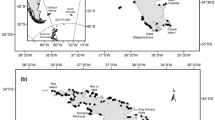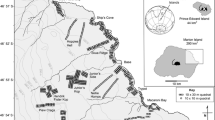Abstract
The white-chinned petrel (Procellaria aequinoctialis) is the seabird most often killed on longlines in the Southern Ocean and is listed as vulnerable to extinction. We estimated the population breeding at the Prince Edward Islands, the last breeding site for the nominate subspecies that lacks a recent population estimate. White-chinned petrel burrows are largely confined to deep, muddy soils, usually on slopes below 200 m, but locally up to 420 m. After correcting for count bias, Marion Island has an estimated 29,900 nests (95 % CI 27,700–32,400). Burrow occupancy rates at the start of the incubation period were 65 % during one-off surveys, but repeat surveys found that at least 73 % of burrows were occupied and 87 % of burrows showed signs of occupancy. This suggests that there were roughly 24,000 occupied nests on Marion Island (95 % CI 20,000–28,000). A more cursory survey on Prince Edward Island yielded 14,700 burrows, suggesting that there are 9,000–15,000 occupied nests. The nominate subspecies of white-chinned petrel occupies approximately 974,200 nests (95 % CI 678,000–1,286,000), with the Prince Edward Islands, the third most important breeding site, after South Georgia and Kerguelen. Assuming that populations breeding at islands in the Atlantic and Indian Oceans winter in different regions, the impact of fishery bycatch is likely to have had a greater impact on the Indian Ocean population. The Marion Island survey provides a baseline against which future population changes can be assessed.

Similar content being viewed by others
References
Barbraud C, Marteau C, Ridoux V, Delord K, Weimerskirch H (2008) Demographic response of a population of white-chinned petrels Procellaria aequinoctialis to climate and longline fishery bycatch. J Appl Ecol 45:1460–1467
Barbraud C, Delord K, Marteau C, Weimerskirch H (2009) Estimates of population size of white-chinned petrels and grey petrels at Kerguelen Islands and sensitivity to fisheries. Anim Conserv 12:258–265
Barnes KN, Ryan PG, Boix-Hinzen C (1997) The impact of the hake Merluccius spp. longline fishery off South Africa on procellariiform seabirds. Biol Conserv 82:227–234
Berrow SD (2000) The use of acoustics to monitor burrow-nesting white-chinned petrels Procellaria aequinoctialis at Bird Island, South Georgia. Polar Biol 23:575–579
Berrow SD, Croxall JP, Grant SD (2000) Status of white-chinned petrels Procellaria aequinoctialis, Linnaeus 1758, at Bird Island, South Georgia. Antarct Sci 12:399–405
BirdLife International (2010) Species fact sheet: Procellaria aequinoctialis. www.birdlife.org. Accessed 10 Oct 2011
Brooke M (2004) Albatrosses and petrels across the world. Oxford University Press, Oxford
Brothers N, Duckworth AR, Safina C, Gilman EL (2010) Seabird bycatch in pelagic longline fisheries is grossly underestimated when using only haul data. PLoS ONE 5(8):e12491. doi:10.1371/journal.pone.0012491
Cooper J, Brown CR (1990) Ornithological research at the sub-Antarctic Prince Edward Islands: a review of achievements. S Afr J Antarct Res 20:40–57
Crawford AB (1952) The birds of Marion Island, South Indian Ocean. Emu 52:73–85
Delord K, Gasco N, Weimerskirch H, Barbraud C (2005) Seabird mortality in the Patagonian toothfish longline fishery around Crozet and Kerguelen Islands, 2001–2003. CCAMLR Sci 12:53–80
Delord K, Cotté C, Péron C, Marteau C, Pruvost P, Gasco N, Duhamel G, Cherel Y, Weimerskirch H (2010a) At-sea distribution and diet of an endangered top predator: relationship between white-chinned petrels and commercial longline fisheries. Endanger Species Res 13:1–16
Delord K, Gasco N, Barbraud C, Weimerskirch H (2010b) Multivariate effects on seabird bycatch in the legal Patagonian toothfish longline fishery around Crozet and Kerguelen Islands. Polar Biol 33:367–378
Huang HW, Liu KM (2010) Bycatch and discards by Taiwanese large-scale tuna longline fleets in the Indian Ocean. Fish Res 106:261–270
Huang HW, Chang KY, Tai JP (2009) The impact of Taiwanese longline fisheries on seabirds in the Atlantic Ocean. Collect Vol Sci Pap ICCAT 64:2398–2404
Inoue Y, Yokawa K, Minami H, Ochi D, Sato N, Katsumata N (2011) Distribution of seabird bycatch at WCPFC and the neighboring area of the southern hemisphere. WCPFC-SC7-2011/EB-WP-07
Martin AR, Poncet S, Barbraud C, Foster E, Fretwell P, Rothery P (2009) The white-chinned petrel (Procellaria aequinoctialis) on South Georgia: population size, distribution and global significance. Polar Biol 32:655–661
Mills MSL, Ryan PG (2005) Modelling impacts of long-line fishing: what are the effects of pair-bond disruption and sex-biased mortality on albatross fecundity? Anim Conserv 8:359–367
Nel DC, Ryan PG, Watkins BP (2002) Seabird mortality in the Patagonian toothfish longline fishery around the Prince Edward Islands, 1996–2000. Antarct Sci 14:151–161
Péron C, Authier M, Barbraud C, Delord K, Besson D, Weimerskirch H (2010a) Interdecadal changes in at-sea distribution and abundance of subantarctic seabirds along a latitudinal gradient in the Southern Indian Ocean. Glob Change Biol 16:1895–1909
Péron C, Delord K, Phillips RA, Charbonnier Y, Marteau C, Louzao M, Weimerskirch H (2010b) Seasonal variation in oceanographic habitat and behaviour of white-chinned petrels Procellaria aequinoctialis from Kerguelen Island. Mar Ecol Prog Ser 416:267–284
Petersen SL, Honig MB, Ryan PG, Underhill LG (2009a) Seabird bycatch in the pelagic longline fishery off southern Africa. Afr J Mar Sci 31:191–204
Petersen SL, Honig MB, Ryan PG, Underhill LG, Goren M (2009b) Seabird bycatch in the demersal longline fishery off southern Africa. Afr J Mar Sci 31:205–214
Phillips RA, Silk JRD, Croxall JP, Afanasyev V (2006) Year-round distribution of white-chinned petrels from South Georgia: relationships with oceanography and fisheries. Biol Conserv 129:336–347
Rand RW (1954) Notes on the birds of Marion Island. Ibis 96:173–206
Reid T, Lecoq M, Catry P (2007) The white-chinned petrel Procellaria aequinoctialis population of the Falkland Islands. Mar Ornithol 35:57–60
Robertson G, McNeill M, Smith N, Wienecke B, Candy S, Olivier F (2006) Fast-sinking (integrated weight) longlines reduce mortality of white-chinned petrels (Procellaria aequinoctialis) and sooty shearwaters (Puffinus griseus) in demersal longline fisheries. Biol Conserv 132:458–471
Ryan PG, Bester MN (2008) Pelagic predators. In: Chown SN, Froneman W (eds) The Prince Edwards Archipelago: land-sea interactions in a changing ecosystem. Sun Media, Stellenbosch, pp 121–164
Ryan PG, Boix-Hinzen C (1999) Consistent male-biased seabird mortality in the Patagonian toothfish long-line fishery. Auk 116:851–854
Ryan PG, Moloney CL (2000) The status of spectacled petrels Procellaria conspicillata and other seabirds at Inaccessible Island. Mar Ornithol 28:93–100
Ryan PG, Ronconi RA (2011) Continued increase in spectacled petrels Procellaria conspicillata. Antarct Sci 23:332–336
Ryan PG, Dorse C, Hilton GM (2006) The conservation status of the spectacled petrel Procellaria conspicillata. Biol Conserv 131:575–583
Ryan PG, Jones MGW, Dyer BM, Upfold L, Crawford RJM (2009a) Recent population estimates and trends in numbers of albatrosses and giant petrels breeding at the sub-Antarctic Prince Edward Islands. Afr J Mar Sci 31:409–417
Ryan PG, Whittington PA, Crawford RJM (2009b) A tale of two islands: contrasting fortunes for Subantarctic skuas at the Prince Edward Islands. Afr J Mar Sci 31:431–437
Schramm M (1986) Burrow densities and nest site preferences of petrels (Procellariidae) at the Prince Edward Islands. Polar Biol 6:63–70
Techow NMSM, Ryan PG, O’Ryan C (2009) Phylogeography and taxonomy of white-chinned and spectacled petrels. Mol Phylogenet Evol 52:25–33
Tuck GN, Phillips RA, Small C, Thomson RB, Klaer NL, Taylor F, Wanless RM, Arrizabalaga H (2011) An assessment of seabird–fishery interactions in the Atlantic Ocean. ICES J Mar Sci 68:1628–1637
van Zinderen Bakker EM Jr (1971) Comparative avian ecology. In: van Zinderen Bakker EM, Winterbottom JM Snr, Dyer RA (eds) Marion and Prince Edward Islands. Report on the South African biological and geological expedition 1965–1966. AA Balkema, Cape Town, pp 161–172
Verwoerd WJ (1971) Geology. In: van Zinderen Bakker EM, Winterbottom Snr JM , Dyer RA (eds) Marion and Prince Edward Islands. Report on the South African biological and geological expedition 1965–1966. AA Balkema, Cape Town, pp 40–62
Watkins BP (2002) Seabird by-catch in the Patagonian toothfish longline fishery at the Prince Edward Islands: 2001–2002. CCAMLR WG-FSA-02/17
Watkins BP, Petersen SL, Ryan PG (2008) Interactions between seabirds and deep-water hake trawl gear: an assessment of impacts in South African waters. Anim Conserv 11:247–254
Waugh SM, MacKenzie DI, Fletcher D (2008) Seabird bycatch in New Zealand trawl and longline fisheries, 1998–2004. Pap Proc R Soc Tasmania 142:45–66
Williams AJ, Siegfried WR, Burger AE, Berruti A (1979) The Prince Edward Islands: a sanctuary for seabirds in the Southern Ocean. Biol Conserv 15:59–71
Woehler EJ (1996) Concurrent decreases in five species of Southern Ocean seabirds in Prydz Bay. Polar Biol 16:379–382
Acknowledgments
An earlier draft of this paper was substantially improved by comments from John Cooper, Karin Delord, and Alan Burger. We thank Mia Cerfonteyn for conducting density estimates on Marion Island and John Cooper, Bruce Dyer, Azwianewi Makhado, Leshia Upfold, and Ross Wanless for assistance with counts on Prince Edward Island. Rob Crawford, Marthan Bester, Delia Davies, Samantha Petersen, Johan Visagie, Dave Whitelaw, and Phil Whittington also assisted with field surveys. Ian Meikeljohn kindly provided elevation data for inland breeding locations at Marion Island. The Department of Environmental Affairs provided logistical support. Financial support was received from the Marine Living Resources Fund, the University of Cape Town and the National Research Foundation (South African National Antarctic Programme). Permission to visit the Prince Edward Islands was granted by the Prince Edward Islands’ Management Committee.
Author information
Authors and Affiliations
Corresponding author
Rights and permissions
About this article
Cite this article
Ryan, P.G., Dilley, B.J. & Jones, M.G.W. The distribution and abundance of white-chinned petrels (Procellaria aequinoctialis) breeding at the sub-Antarctic Prince Edward Islands. Polar Biol 35, 1851–1859 (2012). https://doi.org/10.1007/s00300-012-1227-y
Received:
Revised:
Accepted:
Published:
Issue Date:
DOI: https://doi.org/10.1007/s00300-012-1227-y




